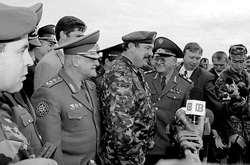Kyiv agrees to replacement of Black Sea Fleet aircraft

Ukraine and Russia seem to have settled a three-year dispute focused on Su-24 bombers appearing in the Black Sea Navy. In any case, Ukrainian Defense Minister Oleksandr Kuzmuk said so after talks with his Russian counterpart Igor Sergeyev in the Crimea where the CIS defense ministers congregated to watch the Ukrainian Duel 1999 naval exercise.
Until then Ukraine was in no hurry to allow Russia's deployment of 22 Su-24m bombers on an airfield at the village of Hvardiyske on the peninsula, replacing the obsolete Su-17. The crux of the matter is that the Su-24m can carry nuclear warheads, and Moscow had been pressing the issue, stressing that Su-17 could no longer be used effectively because of its obsolete design.
In May, NSDC Secretary Volodymyr Horbulin declared, “Ukraine is master in its own territory. Any replacements of Black Sea Fleet weapons systems with modernized versions will change the strategic balance in the Black Sea basin. This can be done only with the knowledge and consent of the Ukrainian side.”
Last week, however, Ukraine's stand in this stand softened noticeably. Mr. Horbulin was quoted as saying, “There appear to be no legal grounds for saying no to the replacement of Su-17 with Su- 24m. However, the Ukrainian side takes a very clear stand: the aircraft must be officially inspected and all accompanying papers verified, so we can be positive that these warplanes are not equipped to carry nuclear weapons. This is our point of departure and here we must find a reasonable solution. But I don't see any big problems here.”
The reasonable solution was sought by the two defense ministers who agreed that the Ukrainian side would carry out inspections twice a year to make sure that the aircraft do not have special devices allowing them to be used as nuclear weapons carriers.
So far it is anyone's guess how such inspections will be carried out. If following a prearranged schedule, such inspections could hardly be described as effective. All international armaments control agreements provide for spot checks making it possible to verify online, that is, firsthand, data. If no such clause was agreed to between Moscow and Kyiv, there are no guarantees, strategic partnership or not, that someone somewhere will not fall prey to the temptation to play a trick on a credulous neighbor. One other thing. The Su-24m planes to be transferred to the Crimea were originally part of the Baltic Fleet, and their crews received full combat training, including use of nuclear weapons. Russia had a chance to redeploy in Ukraine so- called export versions of the Su-24 whose very design rules out the possibility of carrying weapons of mass destruction, but Moscow chose the Baltic Su-24m.
INCIDENTALLY
Prior to the appearance of Su-24m, the Black Sea Fleet's onboard weapon systems were potential carriers of nuclear arms. Thus, the missile-carrying battleship Moskva, recently added to the fleet, is perfectly suited for the purpose. Russian admirals are known to have discussed plans of deploying a nuclear submarine from the Northern Fleet after Russia finishes work on its extra modern nuclear missile-carrying Yuri Dolgoruki. The submarine will then head for the Northern Fleet and its older counterpart will set course on Sevastopol.
Simultaneously, work continues to enhance the so-called Sixth Directorate of the Black Sea Fleet responsible for nuclear combat training. It has moved from Striletska Bay to Nakhimov Square, which hosts another fleet office. The Sixth Directorate is composed of officers who graduated from the Naval Academy, majoring in modern weaponry. Some of them served in the Northern Fleet and are nuclear aircraft experts.
Newspaper output №: Section






